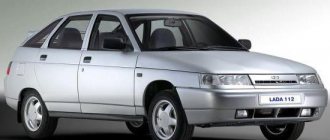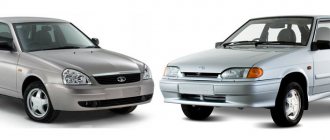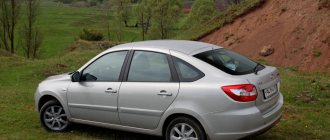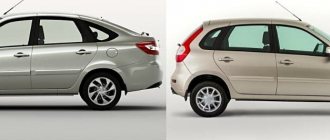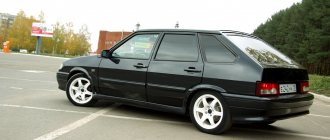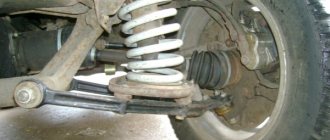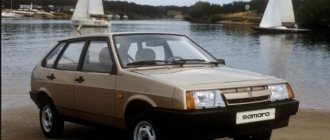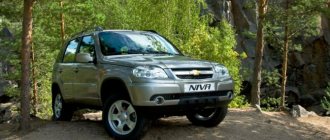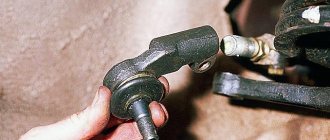Of the entire number of models of the Volzhsky Automobile Plant, many enjoyed the reputation of being truly reliable, economical and simple cars. These include the second generation “Samar” and the tenth family. Even today, young people have a high demand for hatchbacks 2114 and 2112. When searching for a suitable option, the question arises: “VAZ 2114 or VAZ 2112 - which is better?” We will try to figure it out in this article.
Useful video:
Appearance
When comparing cars, it’s worth starting with their appearance. There are quite a few interchangeable parts between the two hatchbacks, but in terms of body design they are radically different. The rounded shapes of the “dvenashka” correspond to modern design trends, while the chopped shapes of the “four” are a little outdated. In fact, the “four” is a copy of the 2109 body, but due to updated optics, bumpers, moldings and interior it is considered a relatively modern car.
Useful: Technical characteristics of the VAZ 2114
When choosing between a VAZ 2112 or a VAZ 2114, you should rely specifically on appearance. There were no particular differences between the engines of the first variations of the “two” and “four” ones. Both cars were equipped with exclusively eight-valve engines. Specifically, the “fourteenth” was never equipped with a carburetor, whereas for early cars of the tenth family such a fuel supply system was not uncommon.
The twelfth model was also based on the 2108 (2109) base, but contained many more innovations, especially in terms of appearance. Rounded shapes still look good on a well-maintained car.
Price policy
As for the cost of cars, a ten would be preferable here. Its purchase will cost the car enthusiast 250 thousand rubles, while the VAZ 2114 will cost about 300 thousand rubles. That is, 20% more expensive. The more attractive design of the VAZ 2110 is due to the presence of parts that can be found even in Priora or Granta. We will end the review here, and draw your own conclusions.
Salon
"Eropanel" on 2114 began to be installed around 2000. Until the last years of production, no changes were made to the interior, with the exception of on-board computers, heated seats and power windows. Panel noise and drying out over time are a common situation for the “14th”. The rear row of seats in the model is a big disadvantage of the car. In fact, the interior is not much different from the nine, but has some advantages in terms of improving the quality of plastic.
Interesting: Photo of VAZ 2114 interior
The tenth "European panels" are in many ways a prefabricated version of European foreign cars. The ergonomics of the buttons, the modern shape of the steering wheel, the presence of full power accessories, electronic airflow flaps, the comfort of the seats and a sufficient amount of space in the back are clear advantages of the “two-wheeler”. If we compare trunk volume, then 2114 wins (430 versus 350 liters).
Interesting: What configurations are there for the VAZ 2114?
Speaking about the old panels on the 2112, comparison with the panels of the “four” is meaningless. The ridiculous shape of the buttons, the noisy panel, the poor quality of the plastic - all this is present in both versions of panels 14 and 12.
general characteristics
So, let's start with the “twelve”. This machine is a derivative of the “ten”, the development of which began during the USSR. The first hatchback was released in 1999. The car was mass-produced until 2008 and underwent minor technical changes (in particular, these are the engines, which we will talk about later). On the basis of this car, the Priora was then created.
As for the “fourteenth”, it is the direct successor of the “nine”. The car was mass-produced from 1997 to 2013. The assembly took place in Tolyatti and Zaporozhye. As he himself says, it is an improved version of the first generation “Samara”. First of all, the changes affected driving performance, braking system and appearance.
Engine
Talking about the engines in both models, it all depends on the year of the car. In different years of production, the same engines were installed on the cars. If at the early stage of the issue 2114 won, because They were equipped with exclusively 8-valve injection engines, but later the situation changed - 16-valve modern engines began to be installed on the 10-valve family.
Only in the 2010s did similar engines begin to be installed on the second generation Samar (124 and 126 units).
Speaking about which gearbox is better than the VAZ 2112 or 2114, it is worth pointing out the obvious disadvantage of both gearboxes - weak synchronizers. With average mileage, a crunching sound appears (in reverse or second gear). In general, both gearboxes are quite reliable, but the tens and twelves have a softer lever stroke. It is rare to repair the box on every hatchback.
Kill me with beauty
The design of these two cars is puzzling for several reasons. But if we need to compare exactly two generations of VAZ front-wheel drive cars, then it would be logical to start with the design, since they are met anyway by their clothes. So 2114 doesn’t fit into any gates even with the design of the late 80s. What the designers wanted to say by covering the entire nine with cheap plastic is unclear, but this act looks like a mockery of the people’s favorite five-door hatchback. This, of course, is a subjective opinion, but how expedient it was to start a story with front headlights of just such a sad shape is unclear. The angular, polished design of the nine disappeared, and the newfangled remnant did not work out. In short, we don't like 2114.
The situation with 2112 is completely opposite. Contrary to all fears, the sedan hatchback turned out to be quite good. The only thing that confuses me is the somewhat visually heavy food. Even when owners lift the suspension, this does not prevent the feeling of heaviness. In general, the design of the tenth family looks very decent, even taking into account the advanced age of development. You can feel the dynamics, but at the same time there is no inflated aggressiveness. Dozens look friendly and do not give in even to the provocations of the tuners. Let's finish with the design here, let's move on to more significant things.
Brake system
The braking performance on most VAZ models has never been very high. During all years of production, the brake scheme was the same: disc brakes in front, drum brakes in the rear. During the first attempts at emergency braking, they are enough to stop effectively, but when they heat up, the brakes begin to “float”, after which they only begin to show their worst side.
Dynamics
When comparing the VAZ 2114 and VAZ 2112, it is worth talking about the dynamics of both cars. Due to their low weight, both are considered very dynamic for their time. If you believe the factory acceleration figures, then 12 is faster. It accelerates to hundreds of kilometers per hour in 12.5 seconds, while the 14 does it in 13.2 seconds. However, the comparison is between the basic 16-valve and 8-valve versions. The fourteenths from Super-Auto accelerate about the same. To answer the question “which is faster than the VAZ 2112 or VAZ 2114?”, it’s worth taking versions with the same engines and doing races. Under equal conditions, a 14 on a Shesnar can outperform a 12 with the same engine due to its lower weight.
Dimensions, ground clearance
In terms of size, these machines are almost identical. Thus, the length of the VAZ-2114 is 4.12 meters, width – 1.65 meters, height – 1.4 meters. Ground clearance is 16.5 centimeters. "Dvenashka" is a little larger. Its body length is 4.17 meters, width – 1.68 meters, height – 1.42 meters. But these parameters are so small that they are not noticed in everyday use. The same goes for ground clearance. On standard 14-inch wheels, this car has 17 cm of ground clearance. Both hatchbacks belong to the B-class and are very compact.
Susceptibility to corrosion
Low quality metal and poor operating conditions cause rapid corrosion of the body on both models. Because The cars are produced at the same plant, there is no need to talk about differences in the quality of the metal. If we consider structurally problematic areas, then on the 2114 these are the arches and the lower edge of the trunk. The power elements on the “four” last a long time. The bottom of the doors and the bottom of the car take longer to rot.
For 2112, the main problem in terms of corrosion is the rear glasses. Due to the accumulation of dirt under these power elements, they rot very quickly. Otherwise, the disadvantages are the same - arches, sills, bottom of doors.
Body stiffness comparison
If you conduct a survey of the owners of these models regarding their attitude to the body, you will find out the following: The VAZ 2110 is ahead of its competitor in all respects. First of all, this refers to the rigidity of the body and its resistance to corrosion. The last factor determines the longer life of the car under equal conditions.
Car enthusiasts also note the aerodynamic characteristics of the tenth model. They are an order of magnitude higher than those of the 14th. This means that the car's speed will be slightly higher.
Advantages and disadvantages of the VAZ 2114
When choosing which car is better to learn in, VAZ 2114 or VAZ 2112, you should consider the pros and cons of each car. First, let’s list the disadvantages of the “four”:
- Noisy and cramped interior. Poor quality plastic and unreliable fasteners cause squeaks or crackles over time;
- Low security. Lack of airbags, weak body;
- Outdated design.
The advantages include the following points:
- Reliability of the main unit - 8-valve engine;
- Only the arches, the bottom of the doors and the trunk are susceptible to corrosion. The power elements are quite strong;
- "Living Suspension"
Depending on the year of manufacture, one can note the presence of body reinforcement in the form of a strut and a more modern 16-valve engine.
Brakes
The VAZ-2112 and 2114 have mixed brakes. There are discs at the front and drums at the rear. Ready-made sets of ventilated discs with perforations are also sold for installation on the front and rear axles.
The cost of a new set with pads, caliper, pad and bracket is about three and a half thousand rubles per side.
Advantages and disadvantages of the VAZ 2112
Speaking about the advantages of twelfths, we need to highlight the following:
- Modern design;
- Spacious interior;
- Availability of hydraulic booster;
- Improved heating system;
- Spacious interior;
- Compared to the “classic” or “Samara”, the 2112 is safer in terms of body strength;
- Build quality.
Because Most cars have 16 valve engines, and power steering is often paired with it. On 14s this option does not exist even in the luxury version from Super-Auto.
The disadvantages of 2112 are few:
- The weak point of the body is the rear glasses;
- Stiff steering in the absence of power steering.
If we consider the interior of the two-wheeler in the “euro” version, then it looks much more advantageous than the “four” interior decoration.
Bottom line
Summing up the comparison and answering the question “which car is better to learn on, VAZ 2114 or VAZ 2112?”, it is worth recognizing the victory of the car from the tenth family. Due to higher safety, the presence of power steering, and a modern engine, the 12 looks advantageous against the background of the modest “four” without power steering with an 8-valve engine. Yes, the version from Super-Auto comes with the same engine, but the panel, as well as the interior decoration, remained at the same level as in the 2000s. In terms of ease of maintenance, Samara-2 wins. Also, do not forget about the minus of the 12th in terms of rotting glasses. Otherwise, everything depends on the current state of the body or technical components in general.
Safety
Despite the fact that VAZ cars are not tested for safety according to European methods, the consumer must at least somehow understand how safe cars of the ninth and tenth families are. Nothing comforting can be said about 2114. According to tests by independent laboratories, the car turned out to be head and shoulders worse than the Nine for completely unknown reasons, since the platform and body are actually the same. 2114 received serious damage during testing, the body could not be restored, and the dummy driver received complex injuries to his dummy brain and legs. This is at a speed of 64 km/h.
The top ten was also beaten, but strangely enough, its body turned out to be stronger than 2114. The hatchback was not tested to the fullest extent of EuroNCAP so as not to be upset again, but in a frontal collision with a 40% overlap under test conditions, the car looked more cheerful and the dummies suffered less damage strongly.
